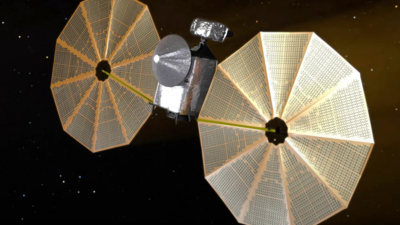- News
- Science News
- NASA’s Lucy spacecraft to fly past asteroid at 30,000 mph as it prepares for a bigger mission
NASA’s Lucy spacecraft to fly past asteroid at 30,000 mph as it prepares for a bigger mission
NASA's Lucy spacecraft is set to fly by the asteroid Donaldjohanson, located 139 million miles away in the asteroid belt. This flyby serves as a crucial test for Lucy's upcoming mission to explore the Trojan asteroids near Jupiter, offering a glimpse into the solar system's early formation. The data collected will help scientists understand the asteroid's size, shape, and composition.
NASA’s Lucy spacecraft will fly past an asteroid named Donaldjohanson this weekend. The asteroid is located 139 million miles from Earth in the asteroid belt between Mars and Jupiter. It is named after the scientist who discovered the famous "Lucy" fossil. During the flyby, Lucy will get as close as 596 miles to the asteroid while travelling at a speed of 30,000 miles per hour. This close encounter will allow Lucy to take pictures and collect information about the asteroid’s size and shape. It’s a key step in preparing for Lucy’s bigger journey to explore ancient space rocks near Jupiter, which could help scientists learn more about how our solar system was formed.
What Is Lucy spacecraft
Lucy is a space probe launched by NASA in 2021 with a special mission to study asteroids that have been floating in space since the early days of the solar system. These asteroids are like ancient fossils in space, helping scientists understand how planets like Earth came to be.
The spacecraft was named after the famous fossil "Lucy," a 3.2-million-year-old skeleton of a human ancestor found in Ethiopia. The fossil was named after the Beatles song "Lucy in the Sky with Diamonds," so NASA included the song's lyrics and even lab-grown diamonds on the spacecraft.
What Lucy will do during the flyby
During the flyby, Lucy will use its instruments to study the asteroid closely. Scientists think the asteroid might look like a bowling pin, a snowman, or possibly even two separate rocks travelling together.
To focus on the asteroid, Lucy will temporarily stop sending signals to Earth and point its instruments at the target. Once the flyby is over, the spacecraft will send back all the data it collected.
Why this flyby matters
This flyby is like a test run for a bigger mission coming up in 2027. That’s when Lucy will start visiting the Trojan asteroids near Jupiter. These space rocks orbit the Sun alongside Jupiter and have never been explored up close.
From 2027 to 2033, Lucy will visit eight of these asteroids to learn more about the early days of the solar system and how planets were formed.
Significance of the mission
These asteroids are not just random space rocks. They are leftovers from the time the solar system was forming. Studying them can give us clues about how Earth and even life itself began.
So as Lucy races through space this weekend, it’s doing something incredible, helping us look deep into the past of our cosmic neighbourhood.

About the Author
TOI Science DeskEnd of Article
Follow Us On Social Media

